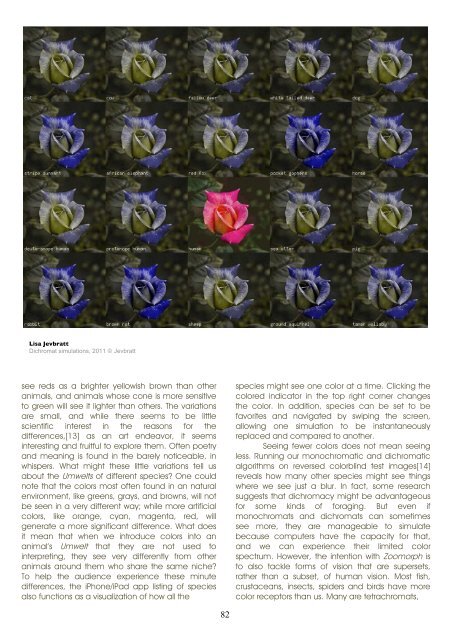Animal Influence I - Antennae The Journal of Nature in Visual Culture
Animal Influence I - Antennae The Journal of Nature in Visual Culture
Animal Influence I - Antennae The Journal of Nature in Visual Culture
Create successful ePaper yourself
Turn your PDF publications into a flip-book with our unique Google optimized e-Paper software.
Lisa Jevbratt<br />
Dichromat simulations, 2011 Jevbratt<br />
see reds as a brighter yellowish brown than other<br />
animals, and animals whose cone is more sensitive<br />
to green will see it lighter than others. <strong>The</strong> variations<br />
are small, and while there seems to be little<br />
scientific <strong>in</strong>terest <strong>in</strong> the reasons for the<br />
differences,[13] as an art endeavor, it seems<br />
<strong>in</strong>terest<strong>in</strong>g and fruitful to explore them. Often poetry<br />
and mean<strong>in</strong>g is found <strong>in</strong> the barely noticeable, <strong>in</strong><br />
whispers. What might these little variations tell us<br />
about the Umwelts <strong>of</strong> different species? One could<br />
note that the colors most <strong>of</strong>ten found <strong>in</strong> an natural<br />
environment, like greens, grays, and browns, will not<br />
be seen <strong>in</strong> a very different way; while more artificial<br />
colors, like orange, cyan, magenta, red, will<br />
generate a more significant difference. What does<br />
it mean that when we <strong>in</strong>troduce colors <strong>in</strong>to an<br />
animal’s Umwelt that they are not used to<br />
<strong>in</strong>terpret<strong>in</strong>g, they see very differently from other<br />
animals around them who share the same niche?<br />
To help the audience experience these m<strong>in</strong>ute<br />
differences, the iPhone/iPad app list<strong>in</strong>g <strong>of</strong> species<br />
also functions as a visualization <strong>of</strong> how all the<br />
82<br />
species might see one color at a time. Click<strong>in</strong>g the<br />
colored <strong>in</strong>dicator <strong>in</strong> the top right corner changes<br />
the color. In addition, species can be set to be<br />
favorites and navigated by swip<strong>in</strong>g the screen,<br />
allow<strong>in</strong>g one simulation to be <strong>in</strong>stantaneously<br />
replaced and compared to another.<br />
See<strong>in</strong>g fewer colors does not mean see<strong>in</strong>g<br />
less. Runn<strong>in</strong>g our monochromatic and dichromatic<br />
algorithms on reversed colorbl<strong>in</strong>d test images[14]<br />
reveals how many other species might see th<strong>in</strong>gs<br />
where we see just a blur. In fact, some research<br />
suggests that dichromacy might be advantageous<br />
for some k<strong>in</strong>ds <strong>of</strong> forag<strong>in</strong>g. But even if<br />
monochromats and dichromats can sometimes<br />
see more, they are manageable to simulate<br />
because computers have the capacity for that,<br />
and we can experience their limited color<br />
spectrum. However, the <strong>in</strong>tention with Zoomorph is<br />
to also tackle forms <strong>of</strong> vision that are supersets,<br />
rather than a subset, <strong>of</strong> human vision. Most fish,<br />
crustaceans, <strong>in</strong>sects, spiders and birds have more<br />
color receptors than us. Many are tetrachromats,












